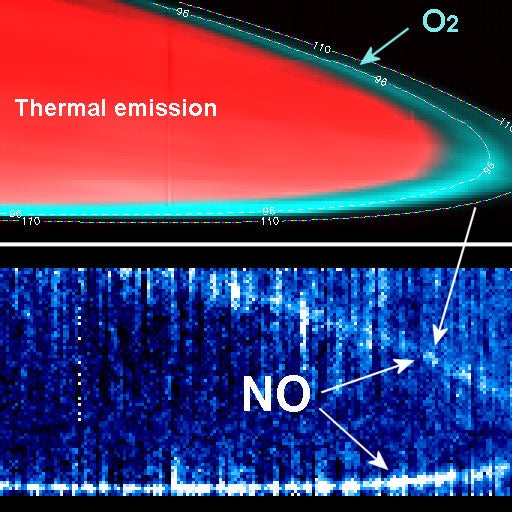The top panel shows the oxygen nightglow of Venus at an altitude of approximately 60 miles (96 kilometers) over the surface of the planet, seen at a wavelength of 1.27 microns.
The bottom panel shows the same portion of the atmosphere observed at the same time, but at a different wavelength (around 1.22 microns). Here it is possible to see the nightglow of nitric oxide, which is much weaker than that of oxygen and comes from an higher altitude – around 68 miles (110 kilometers) above the surface.
In red is the thermal emission of Venus at 1.74 microns – one of the atmospheric windows of Venus exploited by VIRTIS.
European Space Agency’s (ESA) Venus Express spacecraft has observed an eerie glow in the nighttime atmosphere of Venus. This infrared light comes from nitric oxide, and it is showing scientists that the atmosphere of Earth’s nearest neighbor is a temperamental place of high winds and turbulence.
Unfortunately, the glow on Venus cannot be seen with the naked eye because it occurs at the invisible wavelengths of infrared. Venus Express, however, is equipped with the Visible and Infrared Thermal Imaging Spectrometer (VIRTIS) instrument that can see these wavelengths.
VIRTIS has made two detections of the so-called nightglow for nitric oxide at Venus. This is the first time such infrared detections have been made for any planet, and they provide a new insight into Venus’ atmosphere.
“The nightglow can provide details about the temperature, wind direction, composition and chemistry of an atmosphere,” said Antonio Garcia Munoz, who was at the Australian National University when the research was carried out; he is now located at the Instituto de Astrofisica de Canarias, Tenerife, Spain.
The nightglow is ultimately caused by the Sun’s ultraviolet light, which streams into a planet’s atmosphere and breaks up the molecules into atoms and other simpler molecules. The free atoms may recombine again and, in specific cases, the resulting molecule is endowed with extra energy that is subsequently lost in the form of light. On the day-side of the planet, any atoms that find their way back together are outshone by the sunlight falling into the atmosphere.
But on the night-side, where a vigorous diurnal circulation transports atoms, the glow can be seen with appropriate instruments, such as VIRTIS.
A nitric oxide nightglow in the infrared has never been observed in the atmospheres of Mars or Earth, although we know that the necessary nitric oxide molecules are present because they have been observed in ultraviolet.
The nightglow on Venus has been seen at infrared wavelengths before, betraying oxygen molecules and the hydroxyl radical, but this is the first detection of nitric oxide at those wavelengths. It offers data about the atmosphere of Venus that lies above the cloud tops at around 43 miles (70 kilometers). The oxygen and hydroxyl emissions come from 56-62 miles (90-100 kilometers), whereas the nitric oxide comes from 68-75 miles (110-120 kilometers) altitude.
Yet, even VIRTIS cannot see the nitric oxide nightglow all the time because it is often just too faint. “Luckily for us, Venus has a temperamental atmosphere,” said Garcia Munoz. “Packets of oxygen and nitrogen atoms are blown around.” Sometimes these become dense enough to boost the brightness of the nightglow, making it visible to VIRTIS.
Venus Express can observe the three-nightglow emissions simultaneously, and this gives rise to a mystery. The nightglows from the different molecules do not necessarily happen together. “Perhaps when we have more observations, we will understand the correlation between them,” said Garcia Munoz.
In order to do that, the VIRTIS team plans to continue monitoring the planet, building up a database of this fascinating phenomenon.










